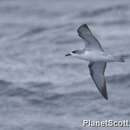en
names in breadcrumbs


The gadfly petrels or Pterodroma are a genus of about 35 species of petrels, part of the seabird order Procellariiformes. The gadfly petrels are named for their speedy weaving flight, as if evading gadflies (horseflies). The flight action is also reflected in the name Pterodroma, from Ancient Greek pteron, "wing" and dromos, "runner".
The short, sturdy bills of these medium to large petrels are adapted for soft prey that they pick from the ocean surface. They have twisted intestines for digesting marine animals that have unusual biochemistries.
Their complex wing and face marking are probably for interspecific recognition.
These birds nest in colonies on islands and are pelagic when not breeding. One white egg is laid usually in a burrow or on open ground. They are nocturnal at the breeding colonies.
While generally wide-ranging, most Pterodroma species are confined to a single ocean basin (e.g. Atlantic), and vagrancy is not as common amongst the genus as in some other seabird species (c.f. the storm petrels Hydrobatidae).
The genus Pterodroma was introduced in 1856 by the French naturalist Charles Lucien Bonaparte.[1] The genus name combines the Ancient Greek pteron meaning "wing" with dromos meaning "racer" or "runner".[2] The type species was subsequently designated as the great-winged petrel by the American ornithologist Elliott Coues in 1866.[3][4]
The species listed here are those recognised in the online list maintained by Frank Gill, Pamela Rasmussen and David Donsker on behalf of the International Ornithological Committee (IOC). The genus includes 35 species, of which one has become possibly extinct in historical times.[5]
The gadfly petrels or Pterodroma are a genus of about 35 species of petrels, part of the seabird order Procellariiformes. The gadfly petrels are named for their speedy weaving flight, as if evading gadflies (horseflies). The flight action is also reflected in the name Pterodroma, from Ancient Greek pteron, "wing" and dromos, "runner".
The short, sturdy bills of these medium to large petrels are adapted for soft prey that they pick from the ocean surface. They have twisted intestines for digesting marine animals that have unusual biochemistries.
Their complex wing and face marking are probably for interspecific recognition.
These birds nest in colonies on islands and are pelagic when not breeding. One white egg is laid usually in a burrow or on open ground. They are nocturnal at the breeding colonies.
While generally wide-ranging, most Pterodroma species are confined to a single ocean basin (e.g. Atlantic), and vagrancy is not as common amongst the genus as in some other seabird species (c.f. the storm petrels Hydrobatidae).